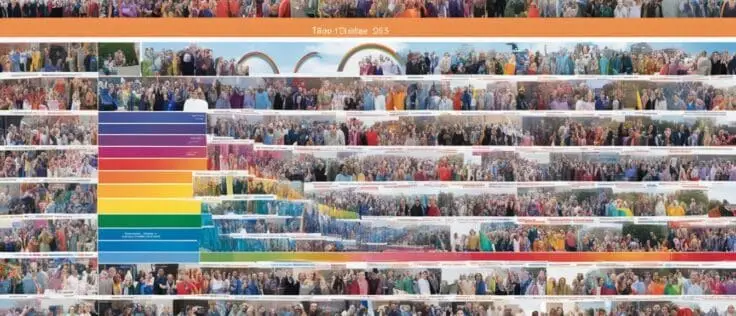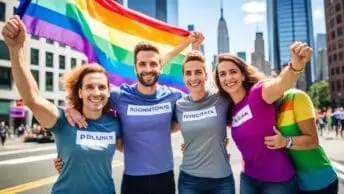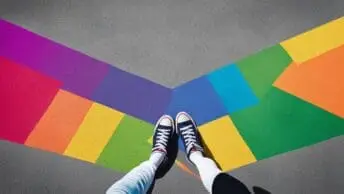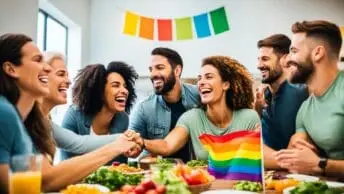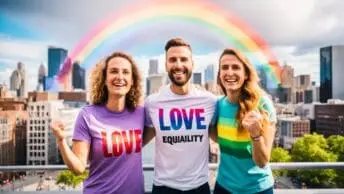Have you ever thought about how one night in 1969 started a movement for LGBTQ+ rights? The story of Pride shows the LGBTQ+ community’s fight and determination. It started with the Stonewall Riots in New York City, a key event for LGBTQ+ rights. Today, people all over the world celebrate Pride. It’s a joyful show of LGBTQ+ identities and a fight for equality.
In the UK, Pride has also had a powerful impact. The first Pride in London in 1972 had about 2,000 marchers for gay rights. By 2019, this number had rocketed to 1.5 million. This growth tells a story of progress and constant advocacy. Despite challenges, like Section 28 in the 1980s, notable progress has been made. The 1990s saw same-sex attraction removed from the list of mental illnesses. There were also big steps like legal same-sex marriage in the 2000s and protection from discrimination.
The history of Pride highlights both achievements and ongoing issues. Unfortunately, hate crimes against LGBTQ+ people are increasing. The murder of Dr Gary Jenkins is a clear sign that there’s still much to do. Current campaigns focus on important changes. These include stopping conversion therapy, helping LGBTQ+ refugees, and ensuring equality in IVF treatment.
Every June, we remember the Stonewall Riots of 1969 during Pride Month. We celebrate the progress made and acknowledge the journey toward true equality that still lies ahead.
The Origins of LGBTQ+ Discrimination
Before the gay liberation movement started, LGBTQ+ people faced severe discrimination. They were wrongly judged by society and laws. Being gay was considered a crime and a mental illness. This negative view was common in the 1960s.
The police often harassed LGBTQ+ folks. They spied on them, trapped them, and raided their spaces. This treatment was unfair and harsh.
Many laws back then made being homosexual a crime. This caused a lot of trouble for LGBTQ+ people. Their struggle led to protests and the start of the Pride movement.
This difficult time shows the big challenges they faced. But it also sparked their fight for rights and acceptance.
The Stonewall Uprising
The Stonewall Uprising of 1969 marks a key point in New York City LGBTQ history. It all started at the Stonewall Inn, a safe place for those often pushed to the edges of society. People of all colours, transgender individuals, drag artists, and people without homes found community here. Located in Greenwich Village, the bar was where the Stonewall Rebellion kicked off after a police raid on June 28, 1969.
Back then, police often targeted gay men with their surveillance and traps. Raids on gay bars happened too frequently. However, on this occasion, the Stonewall Inn’s visitors stood up for themselves. Their fight led to several nights of conflict with the police. It was the start of the modern LGBTQ civil rights movement. Their bravery inspired many who had faced discrimination to stand up and fight.
The impact of the Stonewall Rebellion was huge and lasted for years. By 1969, the actions of LGBTQ activists led to a change in laws. The New York State Liquor Authority had to stop its biased rules against gay bars. On June 28, 1970, New York City hosted its first gay pride march, called Christopher Street Liberation Day. It remembered the rebellion. This march was a foundation for Pride events worldwide, promoting equality and rights for everyone, no matter who they love or how they identify.
Immediate Aftermath and the First Pride March
After the Stonewall Riots on June 28, 1969, the LGBTQ+ community came together quickly. They used their new energy to fight for equal rights and against discrimination. This activism was strong and determined.
The first big step was the Christopher Street Liberation Day on June 28, 1970. It was the first gay pride march and showed they were united after Stonewall. Thousands marched from Greenwich Village to Central Park in New York City.

This march wasn’t just big in New York. It inspired parades in cities like Chicago, San Francisco, and Los Angeles. People like Karla Jay and Mark Segal helped it grow from a few activists to a huge show of unity.
In 1999, Bill Clinton named June “Gay and Lesbian Pride Month”. Barack Obama expanded this in 2011 to include the whole LGBTQ+ community. Pride marches now happen worldwide. They support LGBTQ+ rights and remember the bravery shown after Stonewall.
Pride History: Key Milestones Over the Decades
Over the past several decades, the LGBTQ+ community has made significant strides. The 1970s and 1980s were important times. Groups formed, and gay and lesbian people entered politics. Yet, obstacles like Section 28 in 1988 tried to hold them back. But the LGBTQ+ community didn’t give up, leading to many achievements later on.
In 2000, the UK made a big change by equalising the age of consent. This reduced the difference in treatment between heterosexual and homosexual couples. By 2004, civil partnerships were allowed, giving same-sex couples rights and recognition. The path to equality saw another milestone with the legalisation of same-sex marriage in England and Wales in 2014, and then in Scotland and Northern Ireland.
London Pride has become a major global event. It started with 2,000 people in 1972 and grew to 1.5 million attendees in 2019. Pride celebrations spread across the UK, uniting people, raising visibility, and spreading joy among the LGBTQ+ community and their allies.
Yet, the path hasn’t been easy. Hate and violence against LGBTQ+ people are on the rise, as seen with Dr Gary Jenkins’ murder in 2022. Despite these challenges, the community remains strong. They fight against conversion therapy and push for full equality.
The 50th anniversary of Stonewall in 2019 was deeply meaningful. It wasn’t just about looking back but also continuing the fight. This moment honoured past struggles and achievements, committing to keep striving for LGBTQ+ rights.
Role of LGBTQ+ Organisations in the UK
LGBTQ+ rights groups in the UK are key to advancing equality. Stonewall UK started in 1989, fighting against laws like Section 28. Taking its name from the Stonewall riots, it works for equal rights and recognition for LGBTQ+ people.
These organisations have always fought societal injustices. In 1835, two men were sentenced to death for being in love. By the 19th century, people like Anne Lister were breaking social norms. Lister’s will in 1841 recognised her relationship with Ann Walker, a groundbreaking act.
The work of these groups has evolved with society and laws. By the 20th and 21st centuries, their efforts led to big legal wins. They helped overturn Section 28 and achieve the Marriage (Same-Sex Couples) Act in 2013.
But it’s not just about laws. LGBTQ+ rights groups also provide crucial community support. They offer mental health services, safe places, and cultural events. Their work is vital in fighting for equality and acceptance for LGBTQ+ people in the UK.
The Significance of Section 28
In 1988, under Margaret Thatcher, the UK faced a tough time for LGBTQ+ rights with Section 28. It stopped local authorities and schools from “promoting homosexuality”. So, it silenced support and talks about LGBTQ+ matters in schools. Section 28 lasted until 2000 in Scotland and 2003 in England and Wales. It deeply affected education and pushed the LGBTQ+ community further to the margins.
The stigma against being gay was widespread back then. The 1987 British Social Attitudes Survey showed 75% of people saw homosexual acts as mostly wrong. Section 28 made this worse. But, activists and groups fought hard against it. Their efforts grew, sparking a countrywide campaign to get rid of Section 28.
Notable people like David Cameron, the Conservative leader in 2009, said sorry for the party’s role in Section 28. Its removal was a huge win for LGBTQ+ rights in the UK. It showed progress in fighting educational bias and moving towards acceptance. Section 28’s history reminds us to keep pushing for equal rights for all.
LGBTQ+ Milestones in the UK
The UK has seen many key events that show the growth of LGBTQ+ rights. In the 1950s and 1960s, being gay was against the law, causing a lot of unfair treatment. The turning point came with the 1957 Wolfenden Report. It suggested making being gay legal between adults in private.
1970 was the year of the first UK gay pride rally in London. This event was very important for LGBTQ+ progress. By 2000, the legal age for consent became the same for gay and straight relationships. In that year, gay men could also join HM Armed Forces.
In 2004, civil partnerships were introduced, giving legal rights to same-sex couples. This big change led to the 2013 Marriage (Same Sex Couples) Act. This act made same-sex marriage legal. The first same-sex marriages happened in 2014 in England, Wales, and Scotland. Northern Ireland followed in 2020.
The Equality Act has been crucial in fighting against discrimination for LGBTQ+ people. Yet, challenges like transgender rights and healthcare fairness persist. These milestones show a strong dedication to equality and celebrating LGBTQ+ growth in the UK.
The Ongoing Fight for Equality
The battle for LGBTQ+ rights has seen significant progress. Yet, the fight for true equality is ongoing. Pride Month in June celebrates this fight but also reminds us of the current challenges.
One major concern is the increase in hate crimes against LGBTQ+ people. This shows the urgent need for both legal and social protection for the community.
Many are fighting to ban conversion therapy in places like the UK. This harmful practice tries to change someone’s sexual orientation or gender identity. Groups like InterPride and the Human Rights Campaign are leading the charge against it.
The fight for equality also tackles discrimination in everyday life. Instances where same-sex couples are denied housing because of ‘religious beliefs’ show deep-rooted bias. It’s clear we need more activism and legal changes to give everyone fair treatment.
Pride events are key in raising awareness about these challenges. Organised by groups like Equality Federation, they bring the LGBTQ+ community and allies together. They help boost the movement towards real equality for everyone.
Global Perspective on Pride
Pride began with the Stonewall Riots on June 28, 1969. It has grown into a worldwide movement for LGBTQ+ rights. This all started from a police raid at the Stonewall Inn in New York City. It sparked a global call for LGBTQ+ rights.

The first Gay/LGBTQIA+ Pride Parade was on June 28, 1970. It paved the way for global Pride celebrations. As cities around the world joined in, these parades became symbols of equality. They showed solidarity and support, even in places where persecution exists. London’s first parade on July 1, 1972, was a big moment for UK’s LGBTQ+ advocacy.
Pride’s spread shows how varied LGBTQ+ experiences are worldwide. Even with progress, the struggle for rights goes on. Some countries still enforce anti-gay laws, with harsh penalties. That’s why international Pride events are vital. They promise hope to those living in harsh conditions.
Pride Month is celebrated in June each year. It reminds us of the fight and victories in the LGBTQ+ liberation movement. Events, big and small, honour progress and highlight ongoing issues. Thus, Pride is not just a celebration but a crucial step towards an inclusive world.
The Role of Media and Culture in Shaping Pride
Since the 1990s, we’ve seen more gay individuals in news, TV, and films. This increase has helped change how society views the Pride movement. Shows like “Will and Grace,” “Modern Family,” “Glee,” and “Teen Wolf” have been crucial. They’ve made LGBTQ+ identities more normal and widened cultural acceptance.
Media’s impact on Pride goes beyond any country’s borders. Young people, in particular, are more accepting of homosexuality, thanks to media since the 1990s. This widespread media exposure, along with press freedom, has nurtured more open attitudes. It’s especially true among young people.
The influence of media isn’t limited by geography. The 2014 Sochi Olympics sparked a global conversation on gay rights, highlighted by media coverage. It shows how media can shape views on LGBTQ+ issues worldwide. This happens if national outlets choose to show these stories.
Having free media is vital for the progress of gay rights and better tolerance for stigmatised groups. Media shines a light on Pride Month’s history and the Stonewall Riots of 1969. It educates the public on LGBTQ+ history and matters. Pride Month has evolved from protests to features festivals that celebrate diversity. Parades, events, and media stories all boost LGBTQ+ visibility.
During Pride Month, the media and culture push for LGBTQ+ recognition with various campaigns and artworks. Artist performances and inclusive advertising enhance Pride’s cultural impact. They help build understanding and solidarity across cultures.
However, we still need more positive and diverse LGBTQ+ media representation. Works like “Heartstopper,” “Schitt’s Creek,” “The Owl House,” and “Julian is a Mermaid” stand out for their diversity. But, the challenge of tokenism and limited LGBTQ+ heroes persists. Positive media images are crucial for LGBTQ+ youth. They validate their experiences and help build self-esteem.
People like Dr Ranj have uplifted the LGBTQ+ community through media. Continuing to strive for inclusive and varied representations in media is key. It reflects society’s true diversity and offers comfort and acceptance to everyone.
Modern-Day Pride Celebrations
Today’s Pride celebrations mix joy and activism, celebrating the LGBTQ+ community’s history. They started with the Stonewall Riots in 1969. Now, they’ve grown into worldwide events. Cities like São Paulo, Sydney, and New York City see up to 5 million people joining in.
In June 2000, President Bill Clinton named Pride Month, and President Barack Obama renamed it in 2009. It’s a time to look back on what’s been achieved and the hurdles we still face. The very first Gay Pride Parade in New York City in 1970 had up to 5,000 marchers. The plan for 2024 includes big celebrations in places like Washington, D.C., and Los Angeles.
Pride means parades full of colours and community events that bring people together. These events are vital for promoting and celebrating LGBTQ+ identities. They show the progress made in the rights movement but also remind us of the work left to do. Pride events stand as powerful symbols of the fight and pride of the LGBTQ+ community.
